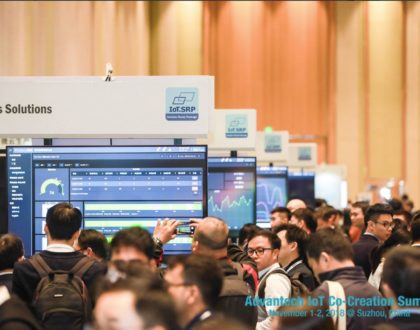Upgrading the Local Intelligence on the Internet of Things
by Mike Fahrion
 As I write this I’m cruising at 32,000 feet and sharing a Wi-Fi Internet connection with 168 other passengers. I don’t know how many handheld wireless devices we’ve got between us but, the Candy Crush addict sitting next to me has already switched between a laptop, a Nexus 7 and a smartphone. A while ago he was kind enough to inform me that he gets five new lives each time he changes devices, which means that he doesn’t have to wait 30 minutes, beg friends for lives on Facebook or pay for new ones. I don’t play the game, so I have no idea what he’s talking about.
As I write this I’m cruising at 32,000 feet and sharing a Wi-Fi Internet connection with 168 other passengers. I don’t know how many handheld wireless devices we’ve got between us but, the Candy Crush addict sitting next to me has already switched between a laptop, a Nexus 7 and a smartphone. A while ago he was kind enough to inform me that he gets five new lives each time he changes devices, which means that he doesn’t have to wait 30 minutes, beg friends for lives on Facebook or pay for new ones. I don’t play the game, so I have no idea what he’s talking about.
Now he’s re-setting the clock in the laptop. I assume that means he’ll evade the 30-minute rule and acquire five more lives. If he does the same thing to his tablet and his smart phone, I suppose he’ll get 10 more. Then every app that relies on the clock, in every device, will start to go haywire. Addiction is a sad and terrible thing.
If I went around and interviewed the rest of the passengers, I’m sure I’d discover that we’re a flying consumer electronics store. In our pockets and carry-ons, we’ve got a wide variety of devices that were pure science fiction just a few years ago. We’ve got smartphones that integrate cellular, Wi-Fi, Bluetooth, GPS, touchscreen HMI and streaming video. We have e-readers that can purchase and download books at the touch of a button, and tablets with high definition TV and internal gyros. A few of these people probably attended the same technology conference that I did. So, I wouldn’t be surprised if we’ve got Google Glass, too.
The conference was about either the Internet of Things, Industry 4.0, or the Ethernet of Everything, depending on whose marketing spin you prefer. The idea, of course, is that devices are becoming increasingly connected, and that these maturing technologies will reshape industry. Looking around the plane, you might be tempted to argue that most of the answers have already been worked out. If you can get more Candy Crush lives from the cloud while flying over Wichita, surely the Internet of Things is already upon on us.
But, it is not that simple. The consumer model assumes that a human user will always be there to input instructions and commands, even if it’s just to play a cloud-based video game. The same user will also manage a device’s power requirements, hopefully remembering to plug the thing into a power source from time to time.
But in the Internet of Things, we will be removing the need for human intelligence in the edge devices. We will want to replace it with physical I/O and software algorithms that can read local conditions, apply business logic, identify what’s important within the data set, and post it to the relevant databases and applications. And we will want edge devices to be self-sustaining. We won’t want to plug them in for a recharge after eight hours of use; we will want them to remain functional for years, or even decades, without any direct human intervention.
That, as it turns out, is a significant challenge. Much harder than disseminating addictive video games from the cloud. But it’s happening as we speak. And those of you who have known me for a while know that I’m right in the thick of things. B+B SmartWorx has always specialized in giving edge devices of every shape and size the ability to talk with one another. Once upon a time that meant connecting machines with protocol converters. Eventually that evolved into local networking and “Industrial Ethernet.” And, that led to a demand for remote networking, which we solve with fiber and cellular solutions. Nowadays, we need to connect edge devices, not just to each other, but to Ethernet networks and the cloud. No single technology is the best for every application yet, so the current incarnation of the Internet of Things uses them all, be it wireless, fiber, copper or cellular. We are bringing more and more connectivity and bandwidth to more and more devices.
(Note that two of our connectivity devices, the Spectre3G-W and the iMcV-Giga FiberLinX-III, have been nominated as finalists in Control Engineering magazine’s 2014 Engineers’ Choice Awards. You can go to http://www.controleng.com/events-and-awards/engineers-choice-awards/2014/finalists.html to give them your vote.)
Soon we’ll be able to distribute localized M2M intelligence across networks in ways that eliminate the need for regular interactions with human operators. And as edge devices become more autonomous and more intelligent, here’s one of my predictions: very few of them will reset their internal clocks so that they can acquire more lives on Candy Crush.
Recommended Posts

Co-Creation, Paving the Way to a More Connected Future
November 27, 2018

The Benefits of a ‘Do It For Me’ Mentality in the IIoT
October 5, 2018

Why You Need to ‘Mind the Gap’ in Manufacturing Technology
August 31, 2018
